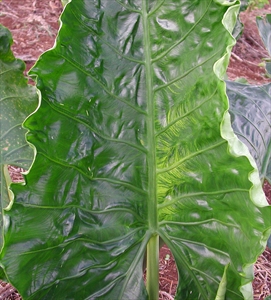Dasheen mosaic
Pacific Pests, Pathogens, Weeds & Pesticides - Online edition
Pacific Pests, Pathogens, Weeds & Pesticides
Taro dasheen mosaic (088)
Dasheen mosaic potyvirus (the abbreviation is DsMV). A severe form of the disease is reported from French Polynesia.
Asia, Africa, North, South (Brazil, Venezuela), Europe, Oceania. It is recorded from Australia, American Samoa, Cook Islands, Federated States of Micronesia, Fiji, French Polynesia, Guam, Kiribati, Marshall Islands, New Caledonia, New Zealand, Nauru, Niue, Northern Mariana Islands, Palau, Papua New Guinea, Samoa, Solomon Islands, Tonga, Vanuatu, and Wallis & Futuna.
All edible aroids are hosts: Alocasia (giant taro), Amorphophallus (elephant foot yam), Colocasia (taro), Cyrtosperma (giant swamp taro), Xanthosoma (tannier, cocoyam), and many ornamental aroids, such as Caladium, Dieffenbachia and Philodendron.
The virus is common in taro (Photos 1&2), as well as in Xanthosoma (Photos 3&4) and Alocasia (Photo 5), and occasionally in Cyrtosperma. Light green streaks appear along the main leaf veins or between them. These streaks form different patterns: some are light green, feather-like patches between the veins (Photo 1), others are over the main veins throughout the leaf (Photo 2).
Occasionally, leaves of taro may be distorted where DsMV patterns occur, especially at the leaf margins (Photo 1). In general, taro show more symptoms than the other edible aroids - Alocasia, Xanthosoma and Cyrtosperma.
Aphids (see Fact Sheet no. 38), or green flies, spread DsMV. Spread occurs when winged adults fly from diseased to healthy plants. The aphids suck up the viruses as they feed on infected plants, and the viruses stick to their mouthparts. The aphids then fly or are blown by wind to healthy plants in the same garden or to other gardens nearby. As the aphids feed again, the viruses enter the plant. The viruses do not multiply inside the aphids, and aphids lose the ability to spread the virus after a short time, unless they feed again on diseased plants.
Apart from being spread by aphids, DsMV is also spread in other ways:
- In planting material. Infected plants are taken to new gardens.
- In sap from infected plants when it comes into contact with healthy leaves; however, this is not thought to be a common method of spread.
- From mother plants to suckers.
The virus is spread rapidly by aphids, but plants do not always show symptoms. In these cases, the viruses is said to be 'latent', i.e., it is present in the plant, but it is not present at concentrations high enough to produce symptoms.
Little is known about the effect of the virus on yield of taro or other related species. Typically, one or two leaves show symptoms followed by healthy-looking leaves. Because the symptoms are not severe it is thought that the effect on corm yield is probably small.
However, in French Polynesia, plants have been reported with a severe strain of the virus (Photos 6&7). It is not commonly seen and occurs only on some varieties.
Look for leaves showing feather-like symptoms, often along the main veins, but sometime between them. The colour of the patterns is yellow-green or grey, distinct from the green of the leaves.
Management of this disease is unnecessary, or likely to be ineffective, for the following reasons:
- Damage due to DsMV does not appear to be serious.
- Aphids are common and will spread DsMV very quickly. There is no way to keep them out of a taro field.
- Chemical control is not a reliable method to stop spread of viruses by aphids. Insecticides can kill aphids, but by the time the aphids die they have already fed and infected healthy plants with virus.
- The virus spreads inside the plant to the suckers, so they cannot be used as a source of virus-free planting material.
- There is no information on resistant varieties. Some varieties may be more resistant than others, but tests have not been done.
It is very likely that every taro grown has an infection of DsMV.
Occasionally, plants with severe symptoms do occur. In these cases, the entire leaf blade shows symptoms, and the leaves remain rolled and perhaps twisted, although they eventually expand. When plants have leaves with these symptoms, it is important to remove the plants and destroy them. If aphids are present, put a rice bag over the plant before pulling it out, and then tip the plant into a fire to destroy it and the insects.
AUTHORS Helen Tsatsia & Grahame Jackson
Information from Carmichael A, et al. (2008) TaroPest: an illustrated guide to pests and diseases of taro in the South Pacific. ACIAR Monograph No. 132, 76 pp. (https://lrd.spc.int/about-lrd/lrd-project-partners/taropest); and from Nelson SC (2008) Dasheen mosaic of edible and ornamental aroids. Cooperative Extension Service, College of Tropical Agriculture and Human Resources, University of Hawai'i at Manoa. https://www.ctahr.hawaii.edu/oc/freepubs/pdf/PD-44.pdf). Photo 4 Mani Mua, SPC. Sigatoka Research Station, Fiji.
Produced with support from the Australian Centre for International Agricultural Research under project PC/2010/090: Strengthening integrated crop management research in the Pacific Islands in support of sustainable intensification of high-value crop production, implemented by the University of Queensland and the Secretariat of the Pacific Community.









